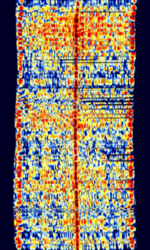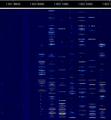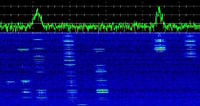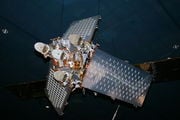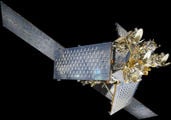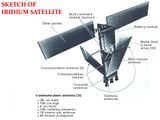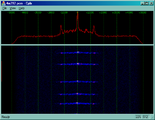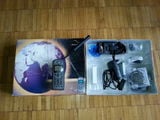Iridium
This is the L-band uplink/downlink for the Low Earth Orbit Iridium Satellite Constellation. This system is used for satellite based phone calls.
Characteristics[edit]
Iridium uses Differentially Encoded QPSKQuadrature Phase-Shift Keying (2 bits per symbol) (DEQPSK) with an occupied bandwidth of 31.5 kHzKiloHertz (kHz) 10^3 Hz. Each channel is spaced 41.667 kHzKiloHertz (kHz) 10^3 Hz from each other as this is the minimum bandwidth needed for receivers to properly receive Iridium signals. Iridium uses both TDMATime Division Multiple Access and FDMAFrequency Division Multiple Access in its transmissions.
The transmitter duty cycle allows for bursted transmission every 8.28 msmilliseconds (.001 of a second) out of 90 msmilliseconds (.001 of a second), or 9.2%, at a rate of 50 kbpsKilobits per second (kbps), with a symbol rate of 25000 bdBaud (unit symbol Bd) is the unit for symbol rate or modulation rate in symbols per second..
For the voice communications, Iridium uses a 2.4 kbpsKilobits per second (kbps) Advanced Multi-Band Excitation (AMBE) vocoder developed by Digital Voice System Inc. (DVSI). This vocoder is tailored to the Iridium communication channel.
Samples[edit]
Iridium TDMATime Division Multiple Access (Sample scaled down from 100kHz to 10 kHzKiloHertz (kHz) 10^3 Hz scale for listening purposes):Frequencies[edit]
The subscriber links are in L-band between 1616 MHzMegaHertz (MHz) 10^6 Hz and 1626.5 MHzMegaHertz (MHz) 10^6 Hz. There are 240 main channels between 1616 MHzMegaHertz (MHz) 10^6 Hz and 1626 MHzMegaHertz (MHz) 10^6 Hz. These are spaced 41.667 kHzKiloHertz (kHz) 10^3 Hz from each other. The center frequency of each channel can be calculated by 1616 + 0.020833(2n - 1) MHzMegaHertz (MHz) 10^6 Hz where (n = 1, ..., 240).
In addition, A 12-frequency access band is reserved for the simplex (ring alert and messaging) channels. These channels are located in a globally allocated 500 kHzKiloHertz (kHz) 10^3 Hz band between 1626.0 MHzMegaHertz (MHz) 10^6 Hz and 1626.5 MHzMegaHertz (MHz) 10^6 Hz. They are:
| Channel Number | Center Frequency | Allocation |
|---|---|---|
| 1 | 1626.020833 MHzMegaHertz (MHz) 10^6 Hz | Guard Channel |
| 2 | 1626.062500 MHzMegaHertz (MHz) 10^6 Hz | Guard Channel |
| 3 | 1626.104167 MHzMegaHertz (MHz) 10^6 Hz | Quaternary Messaging |
| 4 | 1626.145833 MHzMegaHertz (MHz) 10^6 Hz | Tertiary Messaging |
| 5 | 1626.187500 MHzMegaHertz (MHz) 10^6 Hz | Guard Channel |
| 6 | 1626.229167 MHzMegaHertz (MHz) 10^6 Hz | Guard Channel |
| 7 | 1626.270833 MHzMegaHertz (MHz) 10^6 Hz | Ring Alert |
| 8 | 1626.312500 MHzMegaHertz (MHz) 10^6 Hz | Guard Channel |
| 9 | 1626.354167 MHzMegaHertz (MHz) 10^6 Hz | Guard Channel |
| 10 | 1626.395833 MHzMegaHertz (MHz) 10^6 Hz | Secondary Messaging |
| 11 | 1626.437500 MHzMegaHertz (MHz) 10^6 Hz | Primary Messaging |
| 12 | 1626.479167 MHzMegaHertz (MHz) 10^6 Hz | Guard Channel |
Decoding Software[edit]
- Hobby Level Software
- Professional Software
Video Examples[edit]
Additional Links[edit]
- Iridium Satellite Communications
- Iridium Technical Information
- Wikipedia Iridium Satellite Constellation
